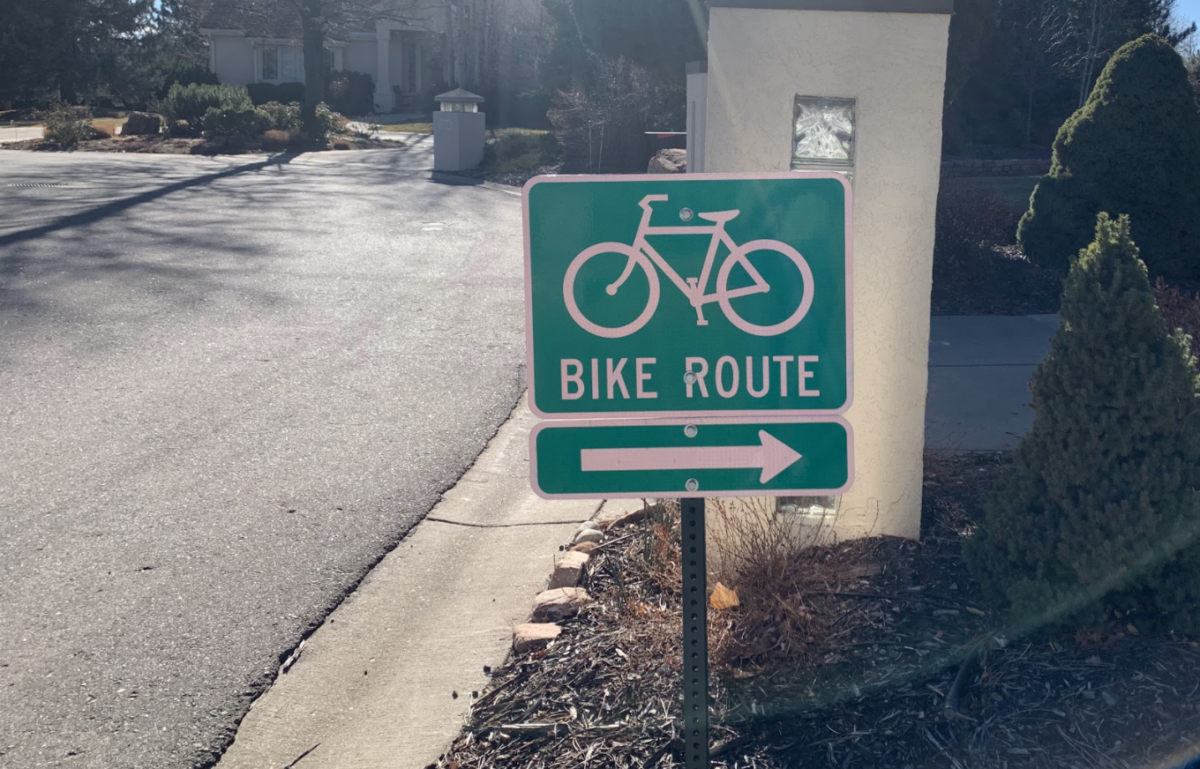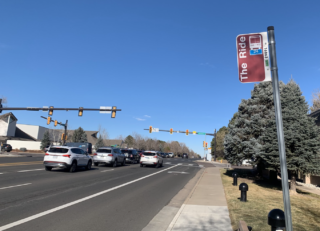
(Photos: Taylor Griggs/BikePortland)
Colorado’s transportation commission recently voted 10-1 to approve a new rule that requires their state Department of Transportation and local planning organizations in Colorado’s five major planning districts to make climate a key priority in any new transportation project, moving focus — and funds — away from highway and road expansions and to improving non-car transit options.
This kind of strict oversight and transparency is something that Oregon climate activists have called for.
As someone who was born and raised in the Denver area, this increased focus on climate-oriented infrastructure in Colorado is particularly interesting to me. I was lucky to grow up in a part of town that’s pretty walkable and bikable, but that wasn’t the case for a lot of people I knew, and I knew very few people who didn’t rely on a car. I’m in Colorado now to spend Christmas with my family, and learning about this new plan to change the very car-centric infrastructure here has made me view my home state with different — and more optimistic — eyes.
“The rule could shift some $6.7 billion by 2050 toward public transit, pedestrian and bicycle infrastructure, construction emission reduction, and other environmentally friendly strategies,” reported Colorado Public Radio.
These new requirements require the state DOT and regional transportation agencies to evaluate the climate impacts of planned projects before moving forward with them, and if they exceed a certain amount, they’ll have to offset emissions. Each project will undergo significant evaluation from a climate and equity-based perspective from the regional and state departments of transportation as well as the state’s transportation advisory committee, and these organizations will also need to provide many opportunities for public participation in the transportation planning process.
“The result of the statewide transportation planning process shall be a long-range, financially feasible, environmentally sound, multimodal transportation system plan for Colorado that will reduce traffic, air pollution, and smog while providing for efficient, resilient, and safe movement of people, goods and services,” reads a snippet from the Colorado Department of Transportation’s (CODOT) document outlining the plan.
These rules were established to meet Colorado’s relatively ambitious greenhouse gas pollution reduction goals that call for a 26% cut in greenhouse gas emissions by 2025 and a 50% cut by 2030 from 2005 levels.
Colorado’s new rules specifically address how the state and regional transportation departments and metropolitan planning organizations plan to ensure every transportation project follows these rules, with penalties if they don’t. The rules state that “in the event that a plan fails to comply, CDOT and MPOs have the option to implement GHG Mitigation Measures that provide travelers with cleaner and more equitable transportation options.” If the plans still don’t demonstrate compliance to the stated greenhouse mitigation measures, CODOT will restrict funding, “requiring that dollars be focused on projects and approved GHG Mitigation Measures that reduce GHG.”
This type of strict oversight and transparency is something that Oregon climate activists have called for from the Oregon Department of Transportation.
Advertisement


Coincidentally, Oregon passed a new Climate Protection Plan (CPP) on the same day the Colorado rules were adopted. Oregon’s CPP is an updated version of a plan that dozens of CPP Rulemaking Advisory Committee members considered inadequate (PDF).

The CPP aims to reduce greenhouse gas emissions by 90% by 2050, the same as Colorado’s goal, but critics in Oregon are skeptical the state will follow through on enforcing the regulations that are necessary for this goal to come to fruition, especially when it comes to transportation projects. Like in Colorado, Oregon’s transportation sector accounts for the largest chunk of greenhouse gas emissions statewide.
As it stands, the state of Oregon is not on track to meet goals necessary to reduce the impact of the climate crisis, and activists are asking for more.
In October, Joe Cortright, a Portland-based economist who focuses on urban economies and has spent years crunching ODOT data, wrote that ODOT has released false environmental claims. In an article published on Strong Towns, Cortright claims that the department of transportation released an insufficient environmental impact report for the controversial I-5 Rose Quarter Freeway widening project and has falsified data about this project’s impact.
“They’ve created trumped-up projections that claim traffic and pollution will be greater if we don’t build freeways. These are false claims,” Cortright states in the blog post. “A key part of the agency’s argument is that this freeway-widening project…will have essentially no impact on air pollution or greenhouse gases. They make the fanciful claim in their Environmental Assessment that the not widening the freeway (the “no-build” option) will somehow produce more pollution than the eight- or 10-lane freeway their plans show they’re really intending to build.”
Cortright says ODOT is misleading the public about how “induced demand” impacts the efficacy of projects like the I-5 expansion. In this context, induced demand means that the more space on a highway will mean more traffic, despite it seeming like that would free up space. A Bloomberg CityLab article published in September also made an example of this freeway expansion, calling it “insanity” to think that expanding a highway will reduce traffic.
Although the Colorado rules leave open the possibility for more highway expansions, the rulemakers acknowledge that expanded highways create more demand in the absence of sufficient non-driving options and emphasize the importance of reducing vehicle miles travelled (VMT).
“The transportation modeling conducted for this rulemaking may demonstrate that certain projects increase GHG pollution for a variety of reasons,” the CODOT document says. “These reasons may include factors such as induced demand as a result of additional lane mileage attracting additional vehicular traffic, or additional traffic facilitated by access to new commercial or residential development in the absence of public transit options or bicycle/pedestrian access that provides consumers with other non-driving options.”
While some climate activists in Colorado wanted the rule to go further and entirely ban highway expansions, what was ultimately passed last week are still some of the most substantial transportation reforms in the country. A Curbed article drew national attention to the idea that Colorado is “showing us how to end American’s addiction to highway expansion,” saying that these rules could serve as a model for other states across the country.
Having lived in both Oregon and Colorado, I can attest to the similarities between the two states. Like other states in the American west, Oregon and Colorado have both suffered catastrophic wildfires, drought and heat events that are directly linked to the climate crisis. Both states have Democratic trifectas in their legislatures and have shown progressive leanings on issues like legalizing marijuana.
And both states are known for natural beauty and outdoor recreation opportunities for tourists and residents who are used to traveling by car to reach rural destinations.
Although the climate crisis will negatively impact outdoor recreation industries in these states, the new Colorado transportation rules met opposition from leaders in more rural parts of the state. Even so, the transportation committee approved the rules.
Transportation reform at the state and local level looks crucial now that the future of the federal Build Back Better bill that would expand infrastructure projects aimed at combatting the climate crisis has only a narrow path to passage. If these new Colorado rules mean substantial change toward more sustainable transportation options that curb emissions, this framework could encourage other states to follow suit.

